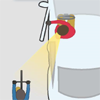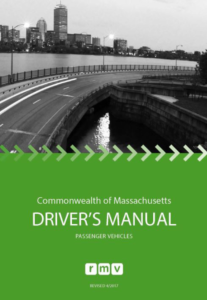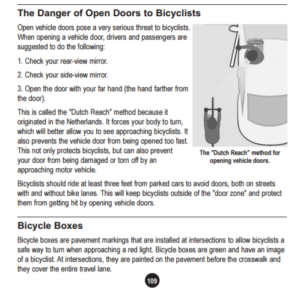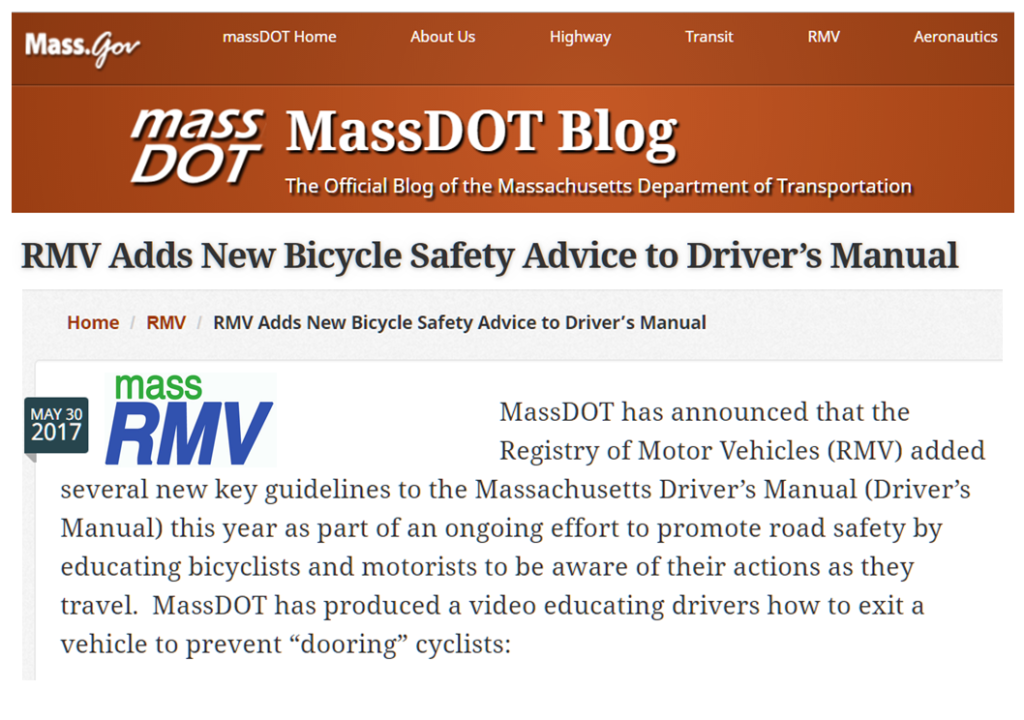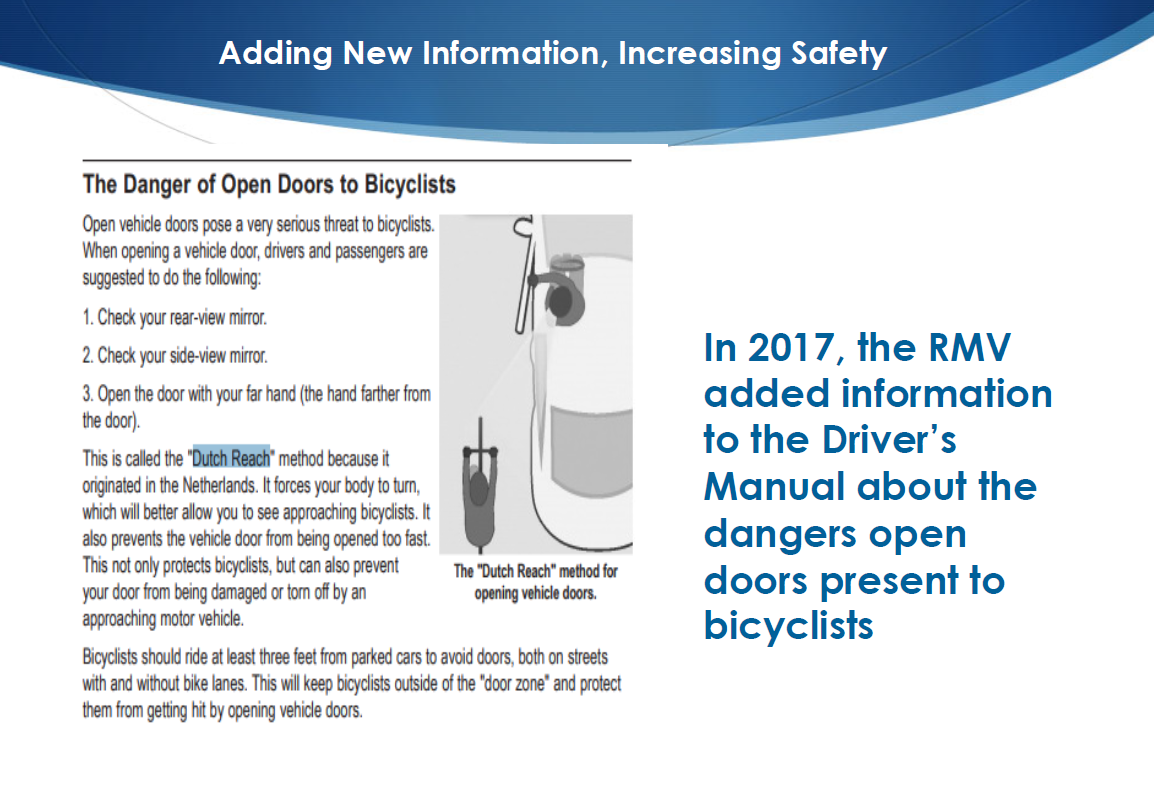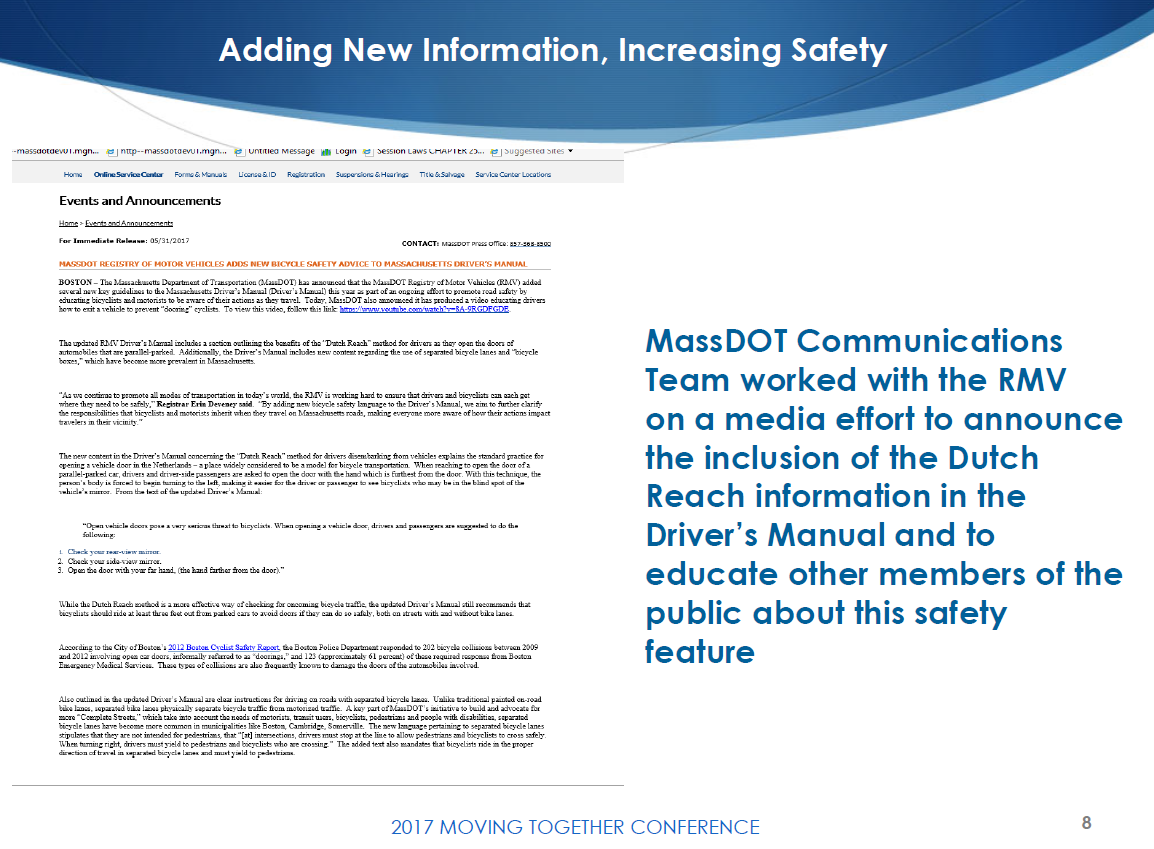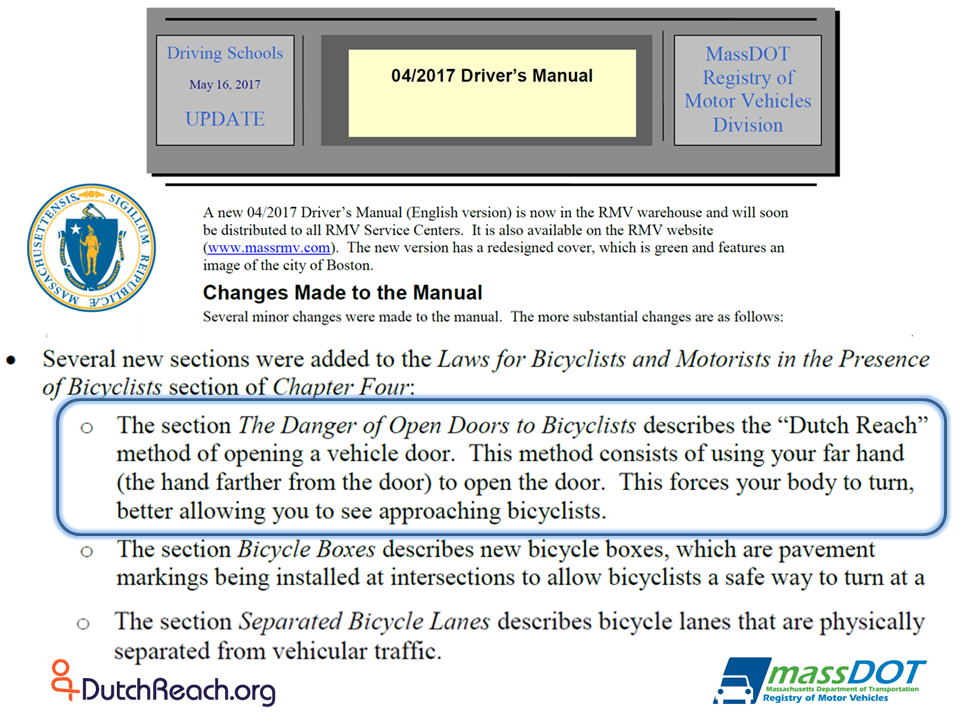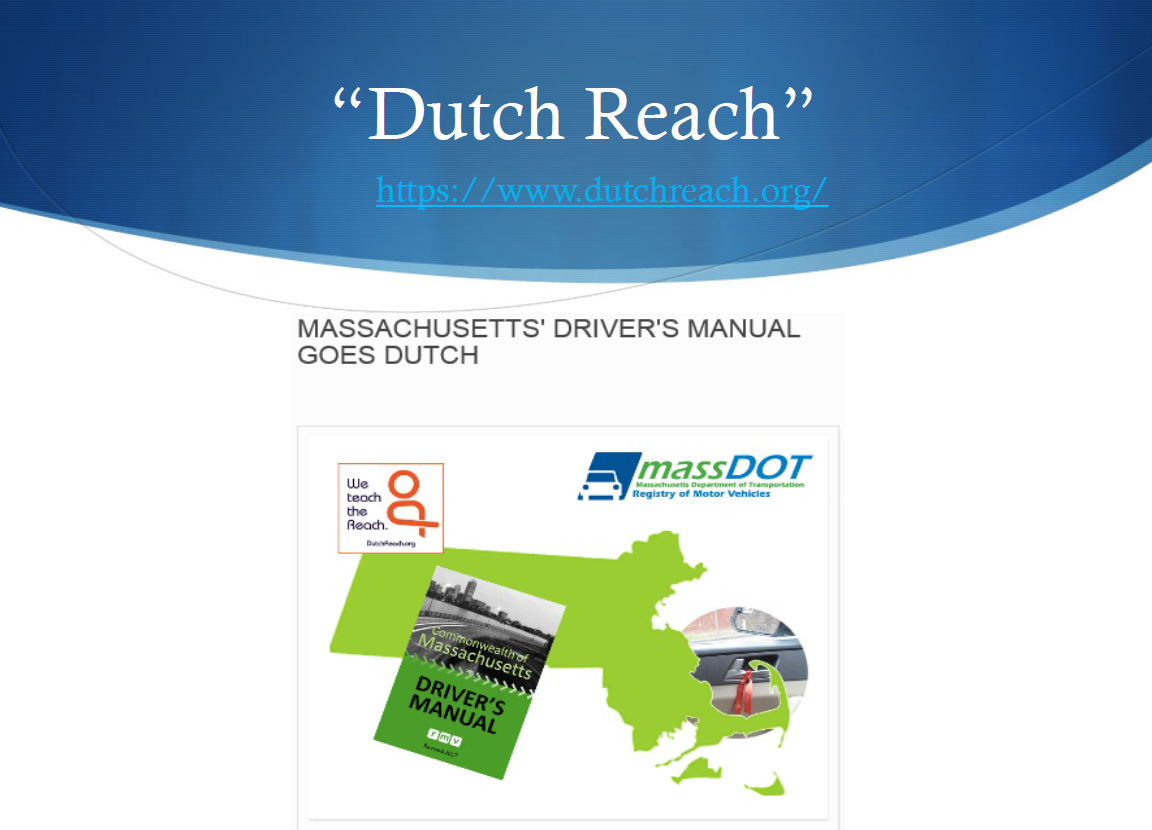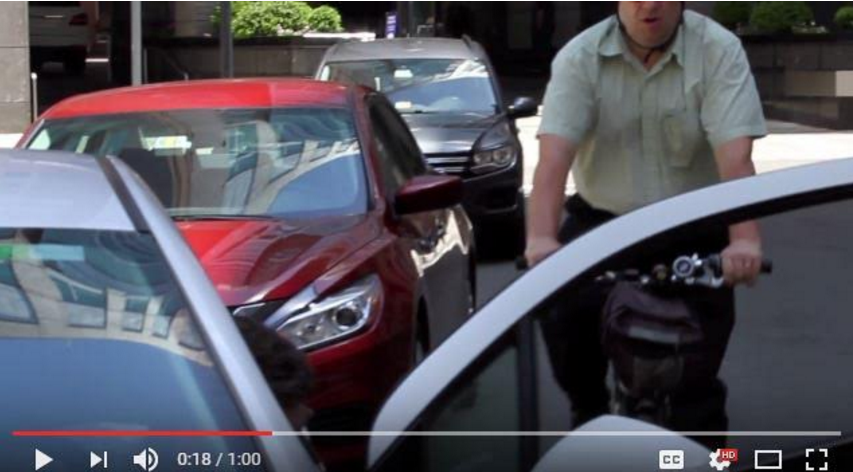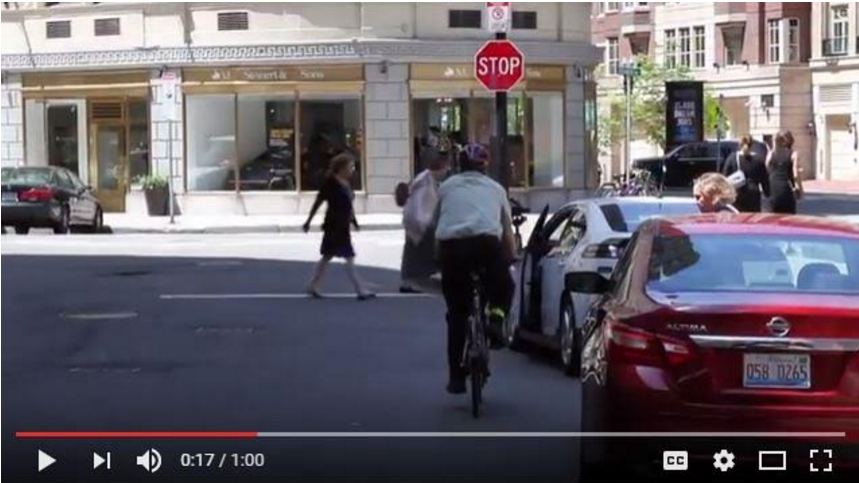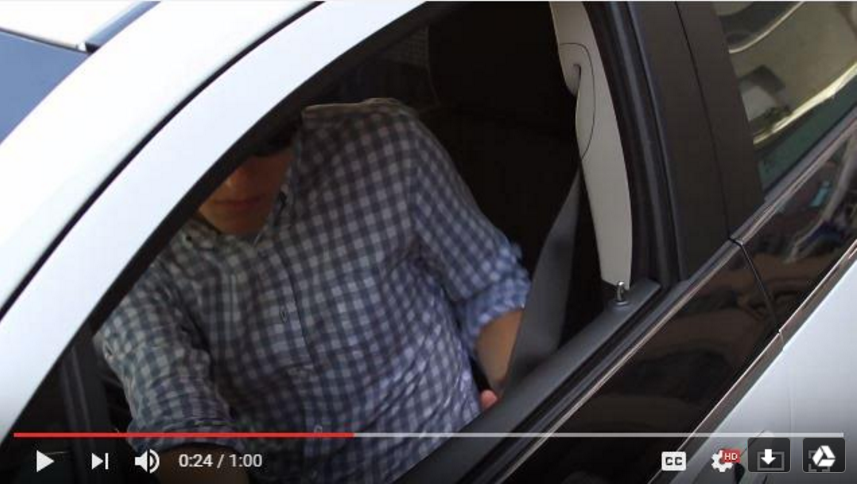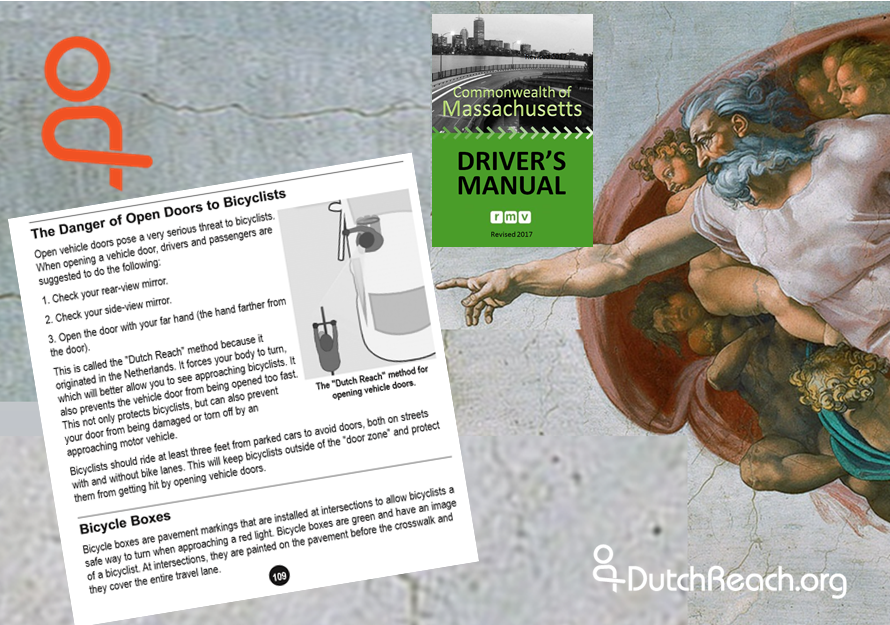NOTE: Click on Top Menu Box for all "NEWS & NEW"
2017 Driver's Manual of the Commonwealth of Massachusetts (USA). Full text pdf (4.3 Mb). Dutch Reach advisory on p. 109.
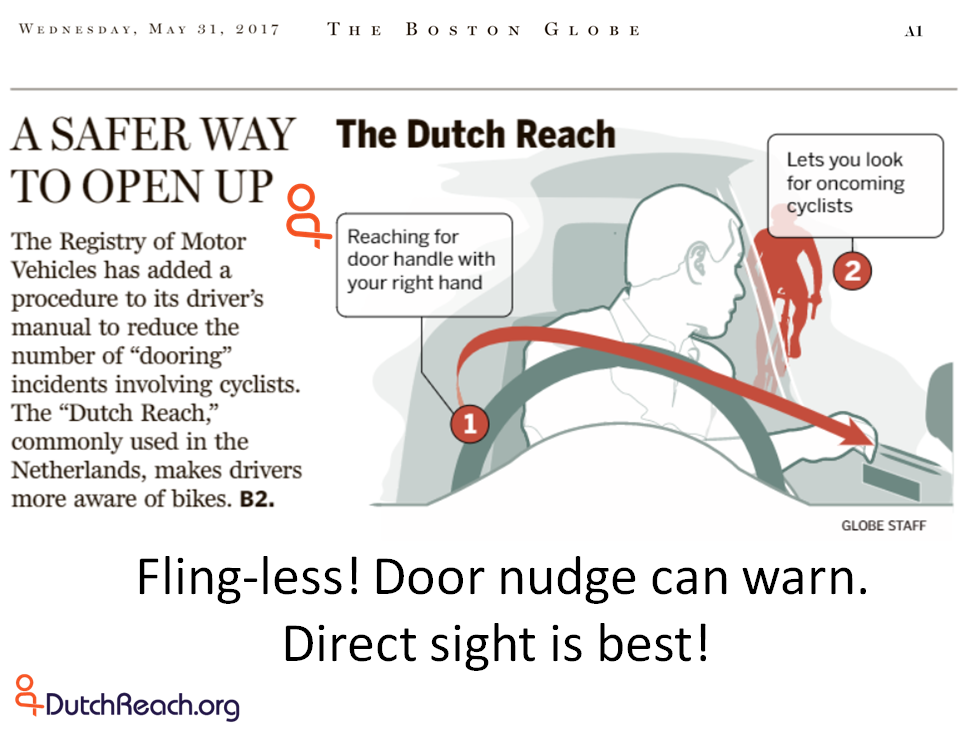
Click image to enlarge. Boston Globe, 5/31/2017, A1. A Safer Way to Open Up.
Praise for Mass. DOT's Dutch Reach Teaching
"This is an important safety measure for everyone -- not just bicyclists," said Dr. Michael Charney, founder of the Dutch Reach Project. "The Dutch method protects all road users from heedless harm in the door zone. Teaching the Dutch Reach to student drivers -- and to all our children -- is the easiest way make this habit swap happen. As the far hand method takes hold, hundreds of bike-car crashes and severe injuries will be prevented. Lives will be spared by this simple move. Is it possible? The Dutch did it so so can we."
...
But the root cause of dooring is driver and passenger error - made worse by our flawed near hand habit which blocks a good 'shoulder check.' The Dutch Reach makes you swivel to look out and to the side. Then you can easily turn your head and look directly back before opening and while exiting: Reach, Turn, Look. Open slowly. If safe, exit facing traffic."
...
“It’s simple, it’s obvious, and it costs nothing. Just swap one thoughtless habit for another thoughtless habit — but the second one is much safer.”
Complete statement & Comments by other safety advocates continued here.
Mass. Adopts Dooring Countermeasure
MassDOT adds ‘Dutch Reach’ to driver’s manual
Boston Globe, May 30, 2017
Steve Annear, Globe Reporter
Online 5/30; Print 5/31
DO IT YOURSELF!
Tools to get the Dutch Reach into your state's Driver's Manual, or adopted by town or city's traffic officials, see Advocacy Toolkit > State Level Actions > State Driver’s Manuals... Also: > Far Hand is Safer &: > Sample Letter to DOT.
Moving Together 2017 - Massachusetts' annual transportation conference.
At the Moving Together Conference 2017, Massachusetts' Registrar of Motor Vehicles Erin Deveney presented MassDOT's recent bike safety and road sharing efforts. Deveney highlighted how and why MassDOT incorporated the Dutch Reach into the RMV Driver’s Manual. and rolled out a public behavior change campaign promoting the method to motorists. The Registrar's full slide presentation may be viewed here.
Three of the slides pertained to MassDOT's Dutch Reach initiative, as seen below and to the right. Click on each to enlarge.
PRESS RELEASE
May 30, 2017
For Official Information
Contact MassDOT Press Office: 857-368-8500
MassDOT Registry of Motor Vehicles Adds New Bicycle Safety Advice to Massachusetts Driver’s Manual
New language aims to reduce “dooring” incidents and other bicycle-automobile collisions
MassDOT posts YouTube video to educate drivers about “dooring”
BOSTON – The Massachusetts Department of Transportation (MassDOT) has announced that the MassDOT Registry of Motor Vehicles (RMV) added several new key guidelines to the Massachusetts Driver’s Manual (Driver’s Manual) this year as part of an ongoing effort to promote road safety by educating bicyclists and motorists to be aware of their actions as they travel. Today, MassDOT also produced a video educating drivers how to safely exit a vehicle to prevent bicyclist injury. To view this video, click https://www.youtube.com/watch?v=8A-9RGDFGDE.
The updated RMV Driver’s Manual includes a section outlining the benefits of the “Dutch Reach” method for drivers as they open the doors of automobiles that are parallel-parked and will include new content regarding the use of separated bicycle lanes and “bicycle boxes,” which have become more prevalent in Massachusetts.
“As we continue to promote all modes of transportation in today’s world, the RMV is working hard to ensure that drivers and bicyclists can each get where they need to be safely,” Registrar Erin Deveney said. “By adding new bicycle safety language to the Driver’s Manual, we aim to further clarify the responsibilities that bicyclists and motorists inherit when they travel on Massachusetts roads, making everyone more aware of how their actions impact travelers in their vicinity.”
The new content in the Driver’s Manual concerning the “Dutch Reach” method for drivers disembarking from vehicles explains the standard practice for opening a vehicle door in the Netherlands, a place widely considered to be a model for bicycle transportation. By reaching to open the door of a parallel-parked car, a driver is asked to open the door with his or her hand which is furthest from the door. With this technique of reaching for the handle, the driver’s body is forced to begin turning to the left, making it easier for the driver to see bicyclists who may be in the blind spot of a motorist’s mirror. From the text of the updated Driver’s Manual:
“Open vehicle doors pose a very serious threat to bicyclists. When opening a vehicle door, drivers and passengers are suggested to do the following:
- Check your rear-view mirror.
- Check your side-view mirror.
- Open the door with your far hand, (the hand farther from the door).”
While the Dutch Reach method is a more effective way of checking for oncoming bicycle traffic, the updated Driver’s Manual still recommends that bicyclists should ride at least three feet out from parked cars to avoid doors if they can do so safely, both on streets with and without bike lanes.
"The Dutch Reach" video by Massachusetts Department of Transportation, Registry of Motor Vehicles. Now posted on YouTube, the video presents the far hand reach method for safe opening & exiting of vehicles to prevent dooring of bicyclists. It also protects drivers & passengers from heedlessly stepping out into danger. [Screen icon to enlarge; Esc to reduce size.]
According to the City of Boston’s 2012 Boston Cyclist Safety Report, the Boston Police Department responded to 202 bicycle collisions between 2009 and 2012 involving open car doors, informally referred to as “doorings,” and 123 (approximately 60 percent) of these required response from Boston Emergency Medical Services. These types of collisions are also frequently known to damage the doors of the automobiles involved.
Also outlined in the updated Driver’s Manual are clear instructions for driving on roads with separated bicycle lanes, which demarcate which part of the road is for bicyclists and which part is for motorized traffic. A key part of MassDOT’s initiative to build and advocate for more “Complete Streets,” which take into account the needs of motorists, transit users, bicyclists, pedestrians and people with disabilities, separated bicycle lanes have become more common in municipalities like Boston, Cambridge, Somerville and can be found elsewhere in the state. The new language pertaining to separated bicycle lanes stipulates that they are not intended for pedestrians, that “[at] intersections, drivers must stop at the line to allow pedestrians and bicyclists to cross safely. When turning right, drivers must yield to pedestrians and bicyclists who are crossing.” The added text also mandates that bicyclists ride in the proper direction of travel in separated bicycle lanes and must yield to pedestrians.
The updated Driver’s Manual also outlines proper procedures for bicyclists and motorists travelling through intersections that contain bicycle boxes. Similar in concept to separated bicycle lanes, bicycle boxes are installed at intersections to allow bicyclists a safe way to turn when approaching a red light. Occupying the space in front of crosswalks, bicycle boxes are painted bright green and contain a large rendering of a bicyclist, which promotes visibility for motorists and bicyclists, even from a distance. From the text of the updated Driver’s Manual:
“Bicyclists who are turning left should stop in the bicycle box, move to the left side of the box, signal the turn, and wait for the green light. Bicyclists traveling straight or turning right should stay to the right in the bicycle box, in a staggered formation, and wait for the green light.
Bicycle boxes can also be used by bicyclists to make a two-stage left turn. A two-stage left turn allows bicyclists to make a left turn in two separate steps, rather than crossing multiple lanes of traffic:
Step 1: Cross straight through the intersection on the green light and stop in the bicycle box for the road you are turning onto.
Step 2: Wait for the green light and go straight through the intersection.”
Drivers who encounter a bicycle box may not enter the bicycle box when the light is red, even when no cyclists occupy the box, and must yield to any bicyclists using the bicycle box before proceeding at a green light. In Massachusetts, bicycle boxes are becoming more common, with some currently delineated at major intersections, such as Somerville Avenue and Medford Street in Somerville, Maffa Way and Cambridge Street in Charlestown, Binney Street and First Street in Cambridge and at Beacon Street and Webster Street in Brookline.
Praise for Mass. DOT's Dutch Reach Teaching
"This is an important safety measure for everyone -- not just bicyclists," said Dr. Michael Charney, founder of the Dutch Reach Project. "The Dutch method protects all road users from heedless harm in the door zone. Teaching the Dutch Reach to student drivers -- and to all our children -- is the easiest way make this habit swap happen. As the far hand method takes hold, hundreds of bike-car crashes and severe injuries will be prevented. Lives will be spared by this simple move. Is it possible? The Dutch did it so so can we."
Doorings account for 10 to 20% of bicycle crashes in many cities across the globe. Riding outside the door zone and putting in separated and protected bicycle lanes are necessary but not always feasible.
But the root cause of dooring is driver and passenger error - made worse by our flawed near hand habit which blocks a good 'shoulder check.' The Dutch Reach makes you swivel to look out and to the side. Then you can easily turn your head and look directly back before opening and while exiting: Reach, Turn, Look. Open slowly. If safe, exit facing traffic."
"Cycling is clearly on the rise in our dense cities. But with miles of car parked streets, flung doors can be instant tragedy for cyclists." A retired physician turned road safety advocate, Charney brought the decades old Dutch dooring solution to the attention of Mass. RMV's Director of Licensing Steve Evans after a young woman was doored and killed near his home in 2016.
Charney coined the quirky name for this little known practice, and started the Dutch Reach Project to make it popular. He hopes current drivers and passengers will make the switch too. "The DOT is already on to this. They've made a very sweet Dutch Reach teaching video, and are even tweeting to get folks to use it."
“It’s simple, it’s obvious, and it costs nothing. Just swap one thoughtless habit to another thoughtless habit — but the second one is much safer.”
Note: See New & News for all current developments. All top-line menu boxes have content, not just drop-down boxes.
